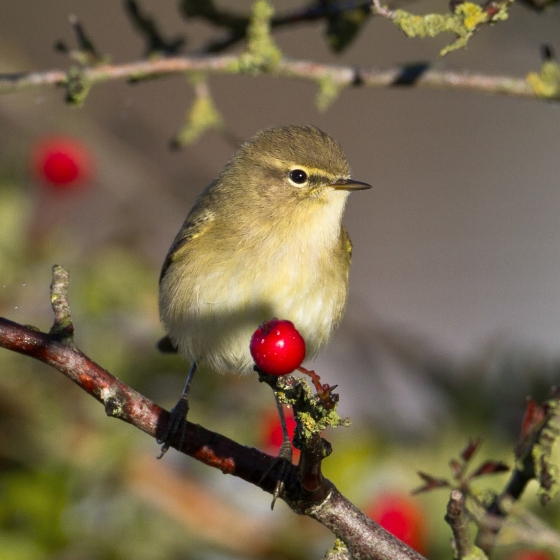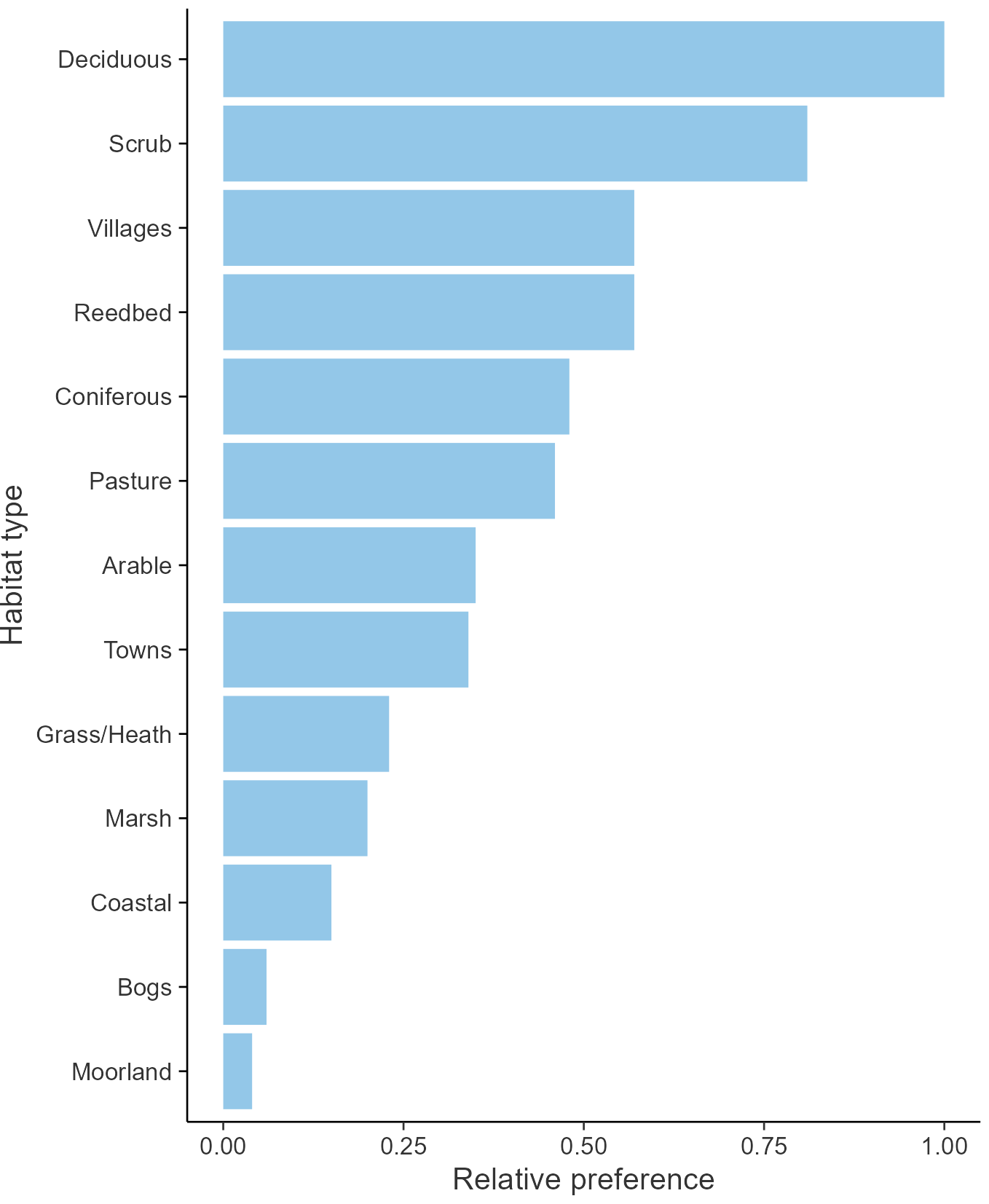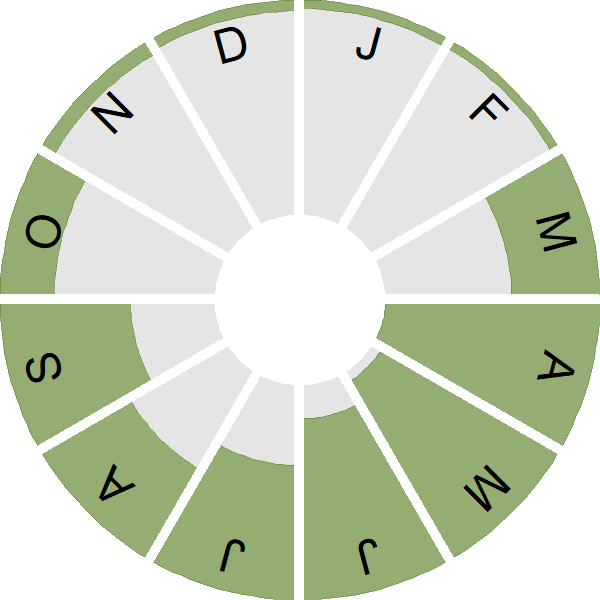Chiffchaff

Introduction
This small warbler is easily identified by its onomatopoeic "chiff chaff" song, after which it was named.
Chiffchaffs breed widely in Britain & Ireland, apart from on the highest ground. In recent years, this species has been expanding its breeding range north into Scotland, with BTO research suggesting it is benefitting from climatic warming in that part of the UK. Breeding Chiffchaff numbers have also risen in the UK in recent decades, especially in Scotland, although there is some indication that this trend is now levelling off. In autumn, many breeding Chiffchaffs depart for southern Europe and North Africa, but increasing numbers are staying for the winter months. They are among the earliest singers in the breeding season, being heard from February onwards.
Chiffchaffs are yellow-olive coloured warblers, that closely resemble a dull Willow Warbler. Luckily, the songs of the two species are very different. Male and female Chiffchaffs look alike. The species favours deciduous woodland and scrub, but can also be found in reedbeds, parks and gardens. It is insectivorous, and can sometimes be spotted catching prey on the wing.
- Our Trends Explorer gives you the latest insight into how this species' population is changing.

Key Stats
Identification
ID Videos
This section features BTO training videos headlining this species, or featuring it as a potential confusion species.
Warbler Identification Workshop Part 1: Willow Warbler & Chiffchaff
#BirdSongBasics: Chiffchaff and Long-tailed Tit
Songs and Calls
Song:
Call:
Status and Trends
Conservation Status
Population Change
Chiffchaff abundance declined in the late 1960s/early 1970s in common with that of other trans-Saharan warblers (Siriwardena et al. 1998a). After remaining stable for a decade, the population recovered strongly, and has continued to increase. This recovery is evident from both CBC/BBS and CES data. The BBS map of change in relative density between 1994-96 and 2007-09 indicates that increase over that period occurred across Britain but that, in Northern Ireland, decrease in the west contrasted with increase in the east. More recent BBS trends show that increases have occurred in England and Wales since 1995, and particularly strong increases in Scotland, with numbers in Northern Ireland fluctuating. There has been an increase across Europe since 1980 (PECBMS: PECBMS 2020a>).
Distribution
Breeding Chiffchaffs are widespread throughout Britain & Ireland, being localised on Scottish islands and absent only from upland areas. Breeding abundance is high throughout much of England, Wales and the southern half of Ireland but generally decreases northwards across Ireland, northern England and Scotland. Wintering Chiffchaff are widely distributed throughout the southern half of Britain, and less widely in Ireland. Winter records farther north in Britain are relatively sparse and occur in coastal or lowland locations.
Occupied 10-km squares in UK
or view it on Bird Atlas Mapstore.
or view it on Bird Atlas Mapstore.
European Distribution Map
Distribution Change
The breeding distribution in Ireland has remained relatively unchanged since the 1970s whereas in Britain there has been a 20% range expansion over the same period, with most of the gains being in northern Britain.
Change in occupied 10-km squares in the UK
or view it on Bird Atlas Mapstore.
or view it on Bird Atlas Mapstore.
Seasonality
Chiffchaff is a scarce winter visitor and common summer migrant, arriving from early March. There is a pronounced passage in August, September and October.
Weekly pattern of occurrence
The graph shows when the species is present in the UK, with taller bars indicating a higher likelihood of encountering the species in appropriate regions and habitats.

Habitats
Breeding season habitats
Relative frequency by habitat
The graph shows the habitats occupied in the breeding season, with the most utilised habitats shown at the top. Bars of similar size indicate the species is equally likely to be recorded in those habitats.

Movement
Britain & Ireland movement
Foreign locations of birds ringed or recovered in Britain & Ireland
Dots show the foreign destinations of birds ringed in Britain & Ireland, and the origins of birds ringed overseas that were subsequently recaptured, resighted or found dead in Britain & Ireland. Dot colours indicate the time of year that the species was present at the location.
- Winter (Nov-Feb)
- Spring (Mar-Apr)
- Summer (May-Jul)
- Autumn (Aug-Oct)

European movements
EuroBirdPortal uses birdwatcher's records, such as those logged in BirdTrack to map the flows of birds as they arrive and depart Europe. See maps for this species here.
The Eurasian-African Migration Atlas shows movements of individual birds ringed or recovered in Europe. See maps for this species here.
Biology
Productivity and Nesting
Nesting timing
Egg measurements
Clutch Size
Incubation
Fledging
Survival and Longevity
Survival is shown as the proportion of birds surviving from one year to the next and is derived from bird ringing data. It can also be used to estimate how long birds typically live.
View number ringed each year in the Online Ringing Report.
lifespan
Survival of adults
Survival of juveniles
Biometrics
Wing length and body weights are from live birds (source).
Wing length
Body weight
Ring Size
Classification, names and codes
Classification and Codes
- Order: Passeriformes
- Family: Phylloscopidae
- Scientific name: Phylloscopus collybita
- Authority: Vieillot, 1817
- BTO 2-letter code: CC
- BTO 5-letter code: CHIFF
- Euring code number: 13110
Alternate species names
- Catalan: mosquiter comú
- Czech: budnícek menší
- Danish: Gransanger
- Dutch: Tjiftjaf
- Estonian: väike-lehelind e. silksolk
- Finnish: tiltaltti
- French: Pouillot véloce
- Gaelic: Caifean
- German: Zilpzalp
- Hungarian: csilpcsalpfüzike
- Icelandic: Gransöngvari
- Irish: Tiuf-Teaf
- Italian: Luì piccolo
- Latvian: cuncinš
- Lithuanian: pilkoji pecialinda
- Norwegian: Gransanger
- Polish: pierwiosnek
- Portuguese: felosinha
- Slovak: kolibiarik cipcavý
- Slovenian: vrbji kovacek
- Spanish: Mosquitero común
- Swedish: gransångare
- Welsh: Siff-siaff
- English folkname(s): Pettychap
Research
Causes of Change and Solutions
Causes of change
Information about the drivers of change for Chiffchaff is limited, but overwinter survival may be the critical factor responsible for changes in abundance.
Further information on causes of change
Climate change may partly explain the strong trend towards earlier laying (Crick & Sparks 1999), which is in line with an advance of two weeks in the arrival dates of Chiffchaff in the UK, between the 1960s and 2000s ( Newson et al. 2016).
Overwinter survival may be the critical factor responsible for changes in abundance, as it is for Whitethroat and Sedge Warbler. These three species all show strong relationships between overwinter survival and population change (Johnston et al. 2016). Productivity as measured by CES has decreased as the population has risen, but there has been no change in fledglings per breeding attempt or in CES survival.
Information about conservation actions
The population of this species has increased since the 1980s with minor fluctuations, hence it is not a species of concern and no conservation actions are currently required.
Research focused on this species is limited and hence few specific conservation actions have been proposed to benefit Chiffchaffs. A study at Wytham Woods found that nests were usually built close to the ground in brambles and that predation was the main cause of failure (Rodrigues & Crick 2010). Management actions to promote understorey vegetation growth would therefore be likely to provide nesting options for Chiffchaffs.
Publications (2)
Spatial variation in spring arrival patterns of Afro-Palearctic bird migration across Europe
Author: Border, J.A., Boersch-Supan, P., Pearce-Higgins, J.W., Hewson, C., Howard, C., Stephens, P.A., Willis, S.G., Houston, A., Gargallo, G. & Baillie, S.R.
Published: 2024
The timing of migrant birds’ arrival on the breeding grounds, or spring arrival, can affect their survival and breeding success. The optimal time for spring arrival involves trade-offs between various factors, including the availability of food and suitable breeding habitat, and the risks of severe weather. Due to climate change, the timing of spring emergence has advanced for many plants and insects which affects the timing of maximum food availability for migratory birds in turn. The degree to which different bird species can adapt to this varies. Understanding the factors that influence spring arrival in different species can help us to predict how they may respond to future changes in climate.
02.05.24
Papers

Breeding ground temperature rises, more than habitat change, are associated with spatially variable population trends in two species of migratory bird
Author: Martay, B., Pearce-Higgings, J.W., Harris, S.J. & Gillings, S.
Published: 2022
BTO research has examined the effects of climate change and habitat loss on the population trends of Willow Warbler and Chiffchaff. These closely related songbirds, tricky to distinguish by eye, share breeding grounds across the UK but migrate to different wintering grounds. While Chiffchaffs mainly migrate to south-west Europe and north-west Africa, with a small number remaining in the UK, Willow Warblers head across the Sahara to the humid zone in central Africa.
03.07.22
Papers


